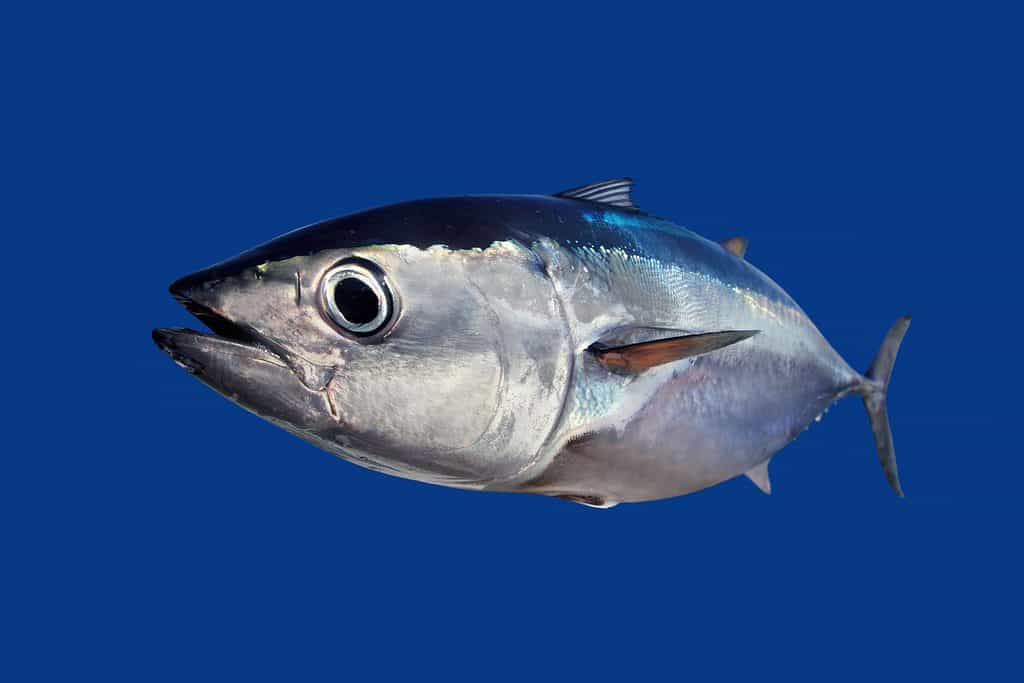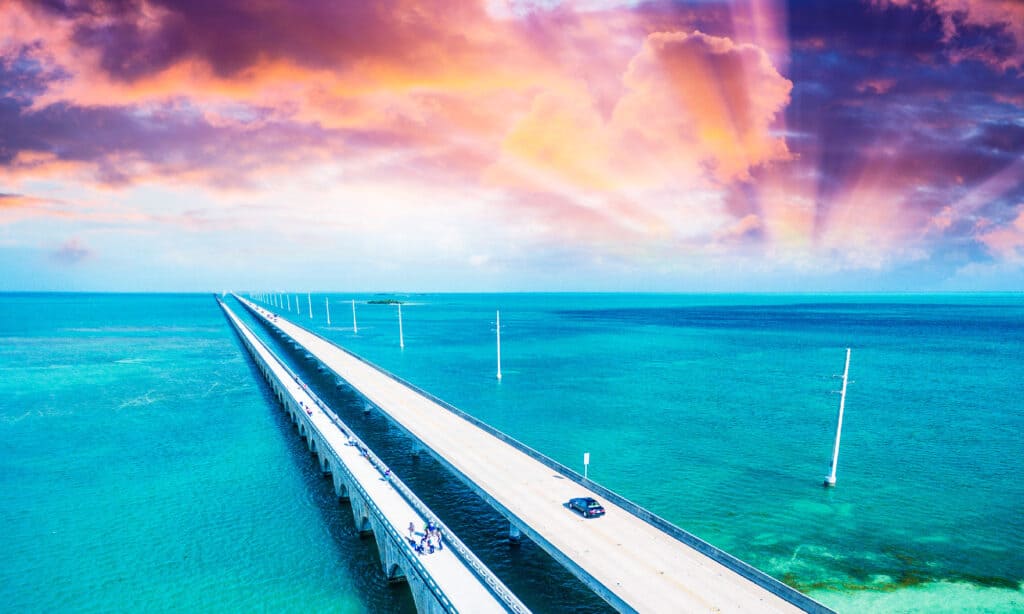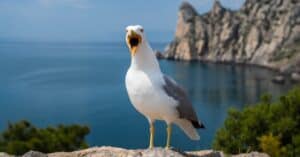Florida is well-known as one of the best fishing destinations not only in the United States but in the world. The blackfin tuna is one of the fish you can find only in the Atlantic, the Gulf of Mexico, and the Caribbean. Even though it’s the smallest of the tuna, it can still grow up to 46 pounds: not too shabby! Keep reading to learn more about these unique fish, their habitat, and their behavior, and discover the largest blackfin tuna ever caught in Florida. At the end, look for some tips to help you get started on breaking that record yourself!

Blackfin tuna are one of many fish species you can catch off the coasts of Florida.
©lunamarina/Shutterstock.com
Meet The Blackfin Tuna
Description
Blackfin tuna also go by the names Bermuda tuna or black-finned albacore. They are fish in the family Scombridae that have bluish-black backs, grey sides, and white bellies. They’re the smallest tuna species, weighing on average about 7 pounds and growing to about 20 inches long. This makes them of less interest for commercial purposes than larger varieties. Still, they can grow as long as 39 inches long and weigh up to 46 pounds. That’s dwarfed by their cousins the Atlantic bluefin tuna which can grow up to 13 feet long and weigh one ton!
Habitat
Unusually for tuna, blackfins have a really limited range. They live only in the Atlantic Ocean, and only in a band from Boston up north to Rio de Janeiro down south. They like warm, clean water, especially in the Gulf of Mexico and the Caribbean Sea. Their intolerance of cold might be one of the reasons they have not spread around the world more: they can’t get past the colder waters of the northern and southern Atlantic to make their way to the rest of the world’s oceans.
Blackfin tuna swim together in large schools. They migrate long distances to find good food sources and places to spawn. Their preference for warm water may be one of the main reasons they have not been able to spread more widely out of their Atlantic range into the oceans of the world.

Blackfin tuna are abundant in the Caribbean. Here, the species is honored on a stamp from the British Virgin Islands
©spatuletail/Shutterstock.com
Diet
Blackfin tuna feed both at the surface and in deeper water, feasting on other fish, squid, shrimp, and crabs, and are sometimes known to eat others of their own species. They will chase larger prey, but they ingest water to suck in smaller prey. They’re highly active fish, so they eat a lot during the day to keep their energy up. Blackfins themselves are prey for numerous other species, including blue marlins, mahi mahi, skipjack tuna, sharks, dolphins, and sea birds. Catching them is not always easy, though, as they can swim at up to 46 miles per hour!
Reproduction
Blackfin tuna spawn off the Florida coast from April through November. The Gulf of Mexico is considered to be their ideal spawning ground because of nutrients flowing into the water from the Mississippi River. During spawning, females release up to 20 million eggs into the water to be fertilized by sperm from males. The resulting larvae float in the water from the surface down as far as 164 feet and hatch within a day or two. Many larvae and fry (young tuna) do not survive to adulthood, but those that do will have a brief life, as this is a short-lived species. At two years old they reach sexual maturity at a weight of 4-6 pounds. They grow quickly and most will not live longer than five years old.
The Largest Blackfin Tuna Ever Caught In Florida
The largest blackfin tuna ever caught in Florida weighed an amazing 49.9 pounds and was caught by Matt Pullen of Hampton, New Hampshire. This fish became the all-tackle world-record blackfin tuna in April and was caught in Florida’s Marathon Hump. The fish, 3.6 pounds heavier than the previous record, was weighed on an IGFA-certified scale. The proud fisherman caught the tuna with a pinfish on a 30-pound line.

The Florida Keys are considered to provide some of the best fishing in the state. Bridges let you drive all the way to Key West.
©pisaphotography/Shutterstock.com
Where Is Marathon Hump Located On A Map?
Marathon Hump, also known as West Hump, is located about 27 miles southeast of Marathon Key, Florida, off the coast of the Florida Keys, in the middle of the Gulf Stream. The Florida Keys are a 125-mile-long chain of islands located south of Miami and are in the Atlantic Ocean, Florida Bay, and the Gulf of Mexico. Florida is in the southeastern region of the United States and is bordered by Alabama to the northwest, Georgia to the north, the Gulf of Mexico to the west, and the Atlantic Ocean to the east.
How Can You Catch Your Own Record-Breaking Tuna?
Blackfin tuna are plentiful and are a species of least concern. They are not as sought-after commercially as some of the truly enormous tuna species, but they taste similar. Blackfin is sushi-grade tuna.
In Florida, fall, winter, and spring are the best times to fish for Blackfin. Anglers can fish them in a variety of ways. These include live baiting, chunking (chopping up bait and throwing it in the water), or vertical jigging (using free-swinging hooks). This last method works particularly well for blackfin tuna. Since they are schooling fish, you may very well catch more than one at a time.
Some of the best blackfin fishing spots in Florida are:
- The Florida Keys is the fishing mecca of the state. Blackfin arrive around mid-November, but December and February are the optimal months for fishing.
- Stuart, on Florida’s Treasure Coast, is a good place for blackfin fishing from March through the summer.
- West Palm Beach is a great place for blackfin year-round. The Gulf Stream is just 10 miles off the coast. Spring and summer are particularly good fishing months.
- Cocoa Beach is close to Disney. It’s a good place to go fishing if you need things for non-fishermen to enjoy. Blackfin are plentiful here from July to August but slowdown in December and January.
- Miami is directly on the Gulf Stream. It gives you access to blackfin all year long. fishing for them will be best in spring and summer.
You will need a fishing permit. Additionally, you must observe a limit of two fish or 100 pounds of fish per day, whichever is more. Check with the locality where you are planning to fish for any other regulations.
The photo featured at the top of this post is © Konstantin G/Shutterstock.com
Thank you for reading! Have some feedback for us? Contact the AZ Animals editorial team.






